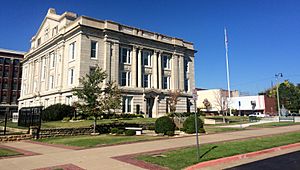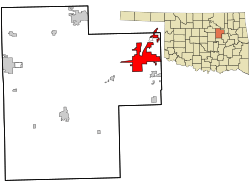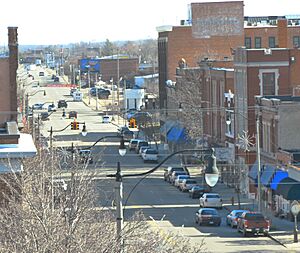Sapulpa, Oklahoma facts for kids
Quick facts for kids
Sapulpa, Oklahoma
|
|
|---|---|

Creek County Courthouse, 2014
|
|
| Motto(s):
"Oklahoma's Most Connected City"
|
|

Location within Creek County and Oklahoma
|
|
| Country | United States |
| State | Oklahoma |
| Counties | Creek, Tulsa |
| Area | |
| • Total | 24.27 sq mi (62.87 km2) |
| • Land | 23.50 sq mi (60.86 km2) |
| • Water | 0.78 sq mi (2.01 km2) |
| Elevation | 719 ft (219 m) |
| Population
(2020)
|
|
| • Total | 21,929 |
| • Density | 933.19/sq mi (360.31/km2) |
| Demonym(s) | Sapulpan |
| Time zone | UTC-6 (Central (CST)) |
| • Summer (DST) | UTC-5 (CDT) |
| ZIP codes |
74066-74067
|
| Area codes | 539/918 |
| FIPS code | 40-65400 |
| GNIS feature ID | 2411831 |
Sapulpa is a city in Oklahoma, located in both Creek and Tulsa counties. It is the main city, or county seat, of Creek County. In 2020, about 21,929 people lived there. This was more than the 20,544 people counted in 2010.
Contents
History of Sapulpa
How Sapulpa Got Its Name
The city of Sapulpa is named after its first permanent settler. He was a Lower Creek Indian man named James Sapulpa. He came from a group called the Kasihta or Cusseta band in Alabama. Around 1850, James Sapulpa set up a trading post near Polecat and Rock creeks. This spot was about one mile southeast of where downtown Sapulpa is today.
Sapulpa's Early Growth
In 1886, the Atlantic and Pacific Railroad built a train line to this area. It became known as Sapulpa Station. The first post office opened on July 1, 1889. The town officially became a city on March 31, 1898.
Industries and Jobs
When Sapulpa was first settled, walnuts were the main crop grown there. Later, in 1898, the Sapulpa Pressed Brick company started. Soon after, the Sapulpa Brick Company also began. This was the start of the clay products industry in the city. Sapulpa was also home to Frankoma Pottery for a long time.
In 1912, the Premium Glass Company opened, bringing glass manufacturing to Sapulpa. This company was later bought by Liberty Glass Company in 1918. Today, the plant makes beer bottles for the Ardagh Group. Other glass factories also operated in Sapulpa, making jars and window glass. Because of all these glass companies, Sapulpa was once called "The Crystal City of the Southwest."
Trains and Transportation
In 1886, the Atlantic and Pacific Railroad extended its tracks to Sapulpa. This railroad later became part of the Frisco system. The Frisco built a large train yard in Sapulpa. By 1900, Sapulpa became a major place for repairing train cars.
Another train line was built from Sapulpa to Oklahoma City in 1898. This line also became part of the Frisco. Over the years, parts of these old Frisco lines changed owners. One section, known as the Sooner Sub, is now owned by the State of Oklahoma.
In 1998, the Sooner Sub line was leased to the Stillwater Central Railroad. In 2014, they bought it. The sale agreement said they had to start daily passenger train service by August 2019. This service was called the Eastern Flyer. If they didn't meet the deadline, they would have to pay a fine. On August 5, 2019, the passenger service had not started, and the Stillwater Central Railroad paid the fine.
Sapulpa also had a streetcar line called the Sapulpa & Interurban Railway (S&I). It connected Sapulpa to Tulsa and other nearby towns like Kiefer and Glenpool. Today, only the part of the line between Tulsa and Sapulpa is still used by the Tulsa-Sapulpa Union Railway.
Route 66 in Sapulpa
Sapulpa is located on old U.S. Route 66. This famous road is now known as SH-66 and Historic Route 66. Along this route in Sapulpa, you can find interesting places.
- The Heart of Route 66 Auto Museum opened in 2016. It is in a building that was once an armory.
- The Tee Pee Drive-In opened in 2017.
- You can see the world's tallest replica of an old gas pump. It is 66 feet tall, or 74 feet if you include the sign on top!
- The Rock Creek Bridge, built in 1921, is still standing. It was an important part of the original Route 66.
Geography and Location
Sapulpa is in the northeast part of Creek County. A small part of the city also reaches into Tulsa County. Downtown Tulsa is about 14 miles northeast of Sapulpa. You can get there using Interstate 44. The Creek Turnpike (State Highway 364) also starts in Sapulpa. It helps drivers go around the south and east sides of Tulsa.
In 2018, the Sapulpa City Council voted to add about 300 acres of land in West Tulsa to the city. This area was bordered by 51st Street, Southwest Blvd, and 65th West Avenue. However, the city later decided to give some of this land back to Tulsa.
The city of Sapulpa covers about 65.1 square kilometers (25.1 square miles). Most of this area, about 63.0 square kilometers (24.3 square miles), is land. The rest, about 2.1 square kilometers (0.8 square miles), is water.
Population and People
| Historical population | |||
|---|---|---|---|
| Census | Pop. | %± | |
| 1900 | 891 | — | |
| 1910 | 8,283 | 829.6% | |
| 1920 | 11,634 | 40.5% | |
| 1930 | 10,533 | −9.5% | |
| 1940 | 12,249 | 16.3% | |
| 1950 | 13,031 | 6.4% | |
| 1960 | 14,282 | 9.6% | |
| 1970 | 15,159 | 6.1% | |
| 1980 | 15,853 | 4.6% | |
| 1990 | 18,074 | 14.0% | |
| 2000 | 19,166 | 6.0% | |
| 2010 | 20,544 | 7.2% | |
| 2020 | 21,929 | 6.7% | |
| Sources: | |||
In 2010, Sapulpa had 20,544 people living in 8,015 households. About 5,497 of these were families. The city had about 844 people per square mile.
- About 77.5% of the people were White.
- About 10.9% were Native American.
- About 3.0% were African American.
- About 4.1% of the population was Hispanic or Latino.
- About 6.3% were from two or more races.
In Sapulpa, about 26.1% of the people were under 18 years old. The average age in the city was 37 years. The average income for a household was about $40,372. For families, it was about $52,639. About 16.3% of the people in Sapulpa lived below the poverty line.
Culture and Education
Sapulpa has an organization called Sapulpa Main Street. It is part of a national program that helps towns keep their history and improve their community. Their goal is to make the downtown area a better place to live and visit.
In 2013, a group of 14 people graduated from a Muscogee Creek language class. This class was held at the Sapulpa Creek Community Center.
Historical Places to Visit
Sapulpa has several places listed on the National Register of Historic Places. These are important sites that are protected because of their history.
- Berryhill Building (14-20 E. Dewey)
- Bridge No. 18 at Rock Creek (on old US Route 66)
- Creek County Courthouse (222 E. Dewey Ave.)
- John Frank House (1300 Luker Ln.)
- McClung House (708 S. Main St.)
- Sapulpa Downtown Historic District (the main downtown area)
- West Sapulpa Route 66 Roadbed (part of the old Route 66)
Parks and Fun Activities
The Sapulpa Parks and Recreation System has 21 parks and recreation areas. These cover over 500 acres of land. Sixteen of these parks are developed and open to the public.
You can find walking trails at several parks, including:
- Kelly Lane Park Trail
- Liberty Park Trail
- Davis Park Trail
- Hollier Park Trail
- Pretty Water Lake Trail
These trails offer walks from a quarter-mile to one mile long.
Pretty Water Lake is a 25-acre lake fed by springs. It is a great spot for fishing. The lake is stocked with trout, channel catfish, and panfish. Sahoma Lake is larger, covering 277 acres. Here, you can fish for largemouth bass, smallmouth bass, crappie, and other types of fish.
In August 2021, a new playground opened at Liberty Park. It is called the "Everyday Heroes" inclusive playground. This playground was designed for everyone, including children aged 2 to 5, 5 to 12, and even adults.
Famous People from Sapulpa
Many interesting people have connections to Sapulpa:
- Bob Ballinger: A politician who taught history in Sapulpa.
- The Collins Kids: Musicians Lorrie and Larry Collins lived near Sapulpa.
- Joe Haymes: A jazz orchestra leader who lived in Sapulpa for many years.
- Regina Holliday: An artist and patient rights advocate who graduated from Sapulpa High School.
- William Miller Jenkins: A former governor of the Oklahoma Territory who lived in Sapulpa later in his life.
- George William Miller: A former U.S. Secretary of the Treasury and Chairman of the Federal Reserve.
- Shara Nova: A singer and songwriter, known for her band My Brightest Diamond.
See also
 In Spanish: Sapulpa (Oklahoma) para niños
In Spanish: Sapulpa (Oklahoma) para niños



